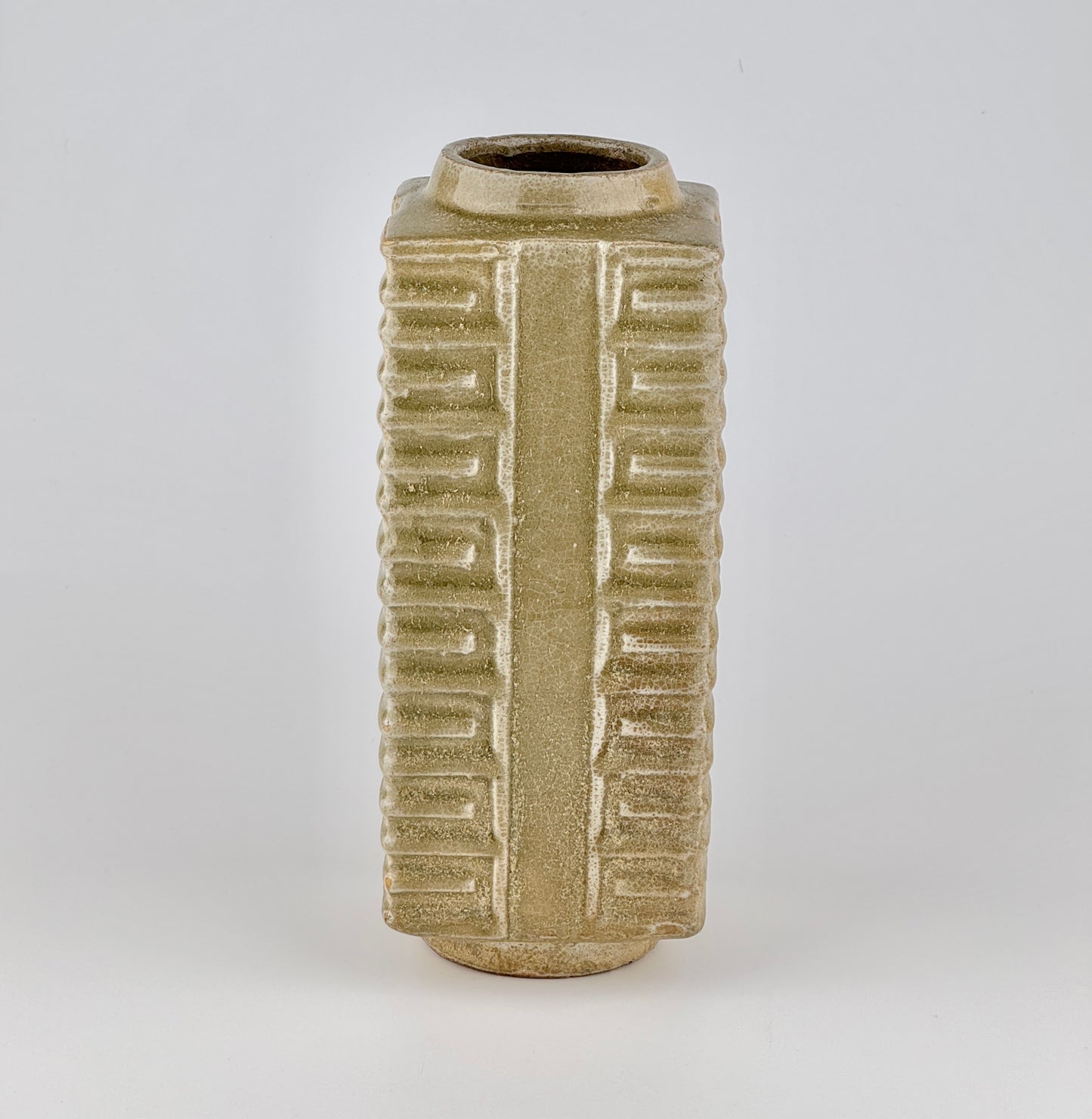AUA Oriental Art
A Rare Yue Celadon Cong-Shaped Vase, Western Jin Dynasty(3-5th C)
A Rare Yue Celadon Cong-Shaped Vase, Western Jin Dynasty(3-5th C)
Couldn't load pickup availability
This vase is an exceptionally rare piece and likely the only known example of a Cong-shaped vase from the Jin Dynasty. While some experts may attribute this work to the Song Dynasty or later periods based on its form, it is, in fact, a much earlier creation from the 3rd to 4th century CE during the Jin Dynasty. It was imported from Hong Kong in the late 1990s and was acquired by our gallery as part of a collection that included other Jin Dynasty Yue celadon pieces.
The vase features a cylindrical form with a square (方形) design and geometric incised patterns. While these design elements became more refined and sophisticated during the Song Dynasty (960–1279), their origins trace back much earlier, as evidenced by Cong-shaped jade artifacts dating as far back as 2,500 B.C.E. Examples of these ancient jade Congs can be found in the collections of the British Museum and the Metropolitan Museum of Art (MET). The form of these jade pieces aligns precisely with what is known as Cong-shaped porcelain, establishing them as the true predecessors of later ceramics.
The glaze exhibits a characteristic Yue Ware quality of Western Jin, muted olive-brown hue. The somewhat rough texture of the surface is also a distinctive trait of early celadon from the Western Jin period.
Period : Jin Dynasty (266 - 420 AD)
Type : Cong-Shape Vase
Medium : Yue celadon(Stoneware)
Size : 27.5cm(Height), 11cm(Diameter)
Provenance : The piece was acquired in Hong Kong in the late 1990s.
Condition : Good(Traces of excavation on one side (caused by being laid on that side))
Reference :
1) MET - Ritual object (cong) - Object Number: 2004.52
(Type : related)
https://www.metmuseum.org/art/collection/search/72376
2) Christies Hongkong 30 May 2023 - A RARE YUE CELADON CIRCULAR TRIPOD INK STONE AND COVER - Lot 3318
(Price : 189,000 HKD / Type : Related)
https://www.christies.com/en/lot/lot-6427808
3) British Museum - Jade Cong, Liangzhu Culture, 2,500 B.C.E.
(Type : Related)
https://www.britishmuseum.org/collection/galleries/chinese-jade
4) Sotheby's Newyork 18 September 2024 - A 'Yue' celadon-glazed ram-form water vessel, Western Jin dynasty - Lot 232
(Price : 12,000 USD / Type : Related)
https://www.sothebys.com/en/buy/auction/2024/chinese-art/a-yue-celadon-glazed-ram-form-water-vessel-western
* Yue Celadon
Yue celadon, also known as Yue ware, is a type of Chinese pottery with a celadon glaze, originating from the eastern Han dynasty (25-220 AD) in the Zhejiang province. The name 'Yue' comes from the Yue kilns which were among the earliest to develop the celadon technique. Yue ware is known for its jade-like glaze, which can range in color from bluish-green to olive green.
Yue celadon was highly regarded during its time and was the first Chinese ware to be imported in large quantities to the Middle East and Africa, significantly influencing the development of ceramics in those regions. The production of Yue ware continued to evolve, and during the Tang dynasty (618-907 AD), it became more refined with more complex shapes and decorations. By the time of the Song dynasty (960-1279 AD), it had greatly influenced other kiln traditions, leading to the development of the classic longquan celadon, which became one of China’s most famous ceramic products.
Yue celadon traditionally embodies elements of auspiciousness and good fortune in Chinese culture. The jade-like celadon glaze is often associated with longevity and health. Various motifs and shapes inscribed on the pottery frequently symbolize luck and prosperity. For example, lotus patterns may represent purity and immortality, while animal figures like the lion symbolizes power, courage, and strength. Lions are considered protectors that ward off evil spirits and bring forth good luck. Furthermore, Yue celadon wares were commonly used as tomb offerings in ancient China, believed to bring fortune and well-being to the deceased in the afterlife.
Share






































